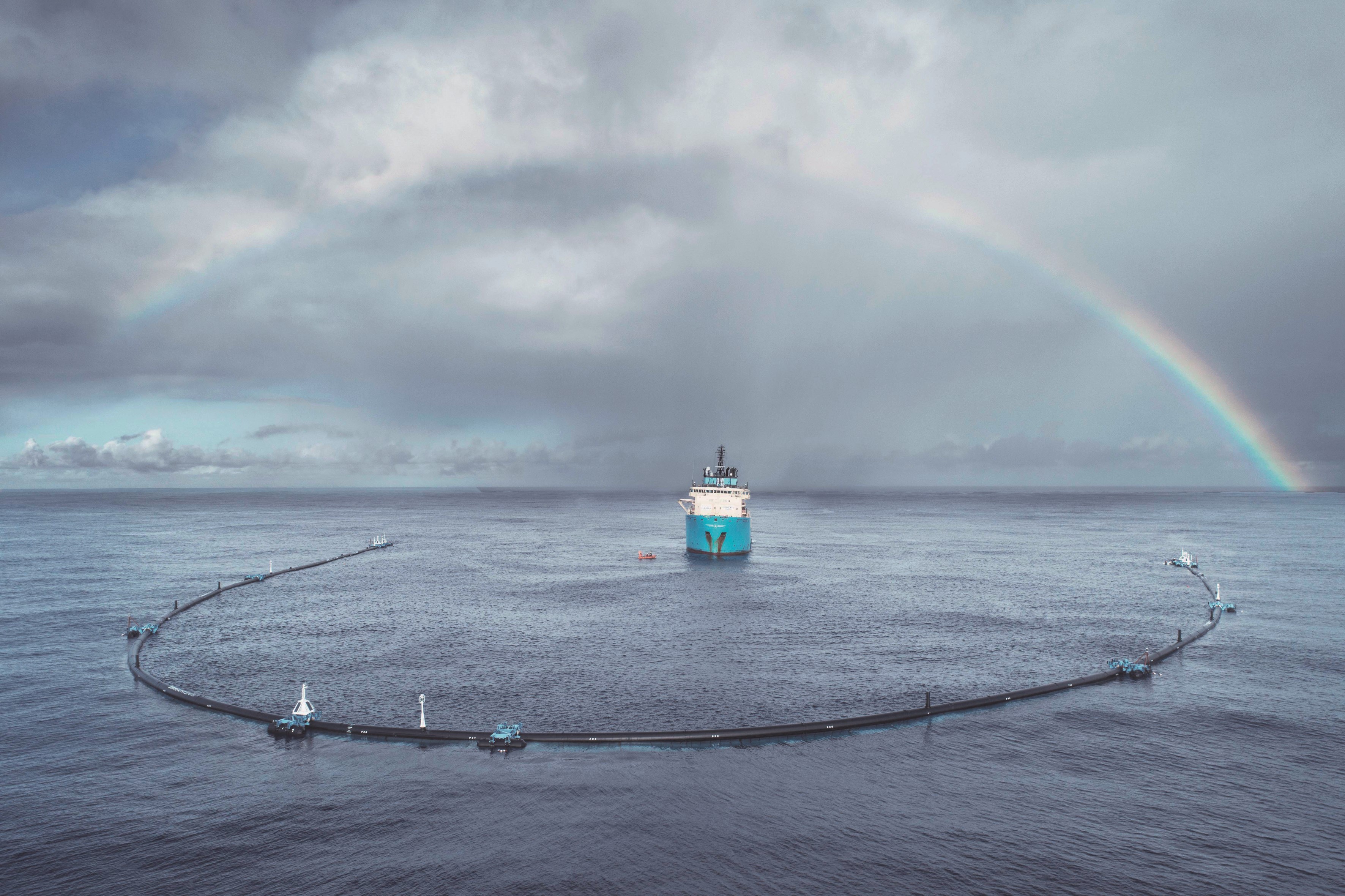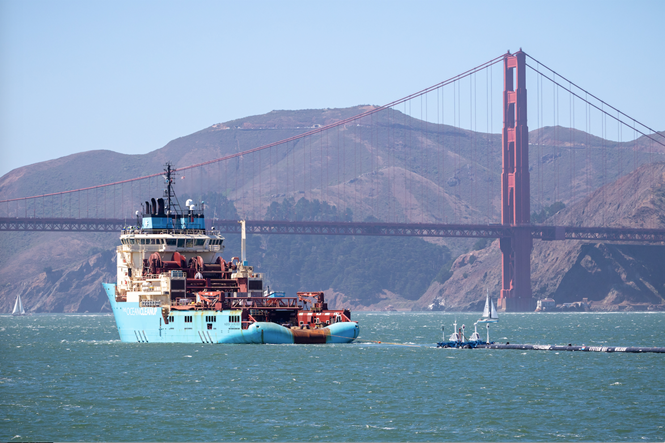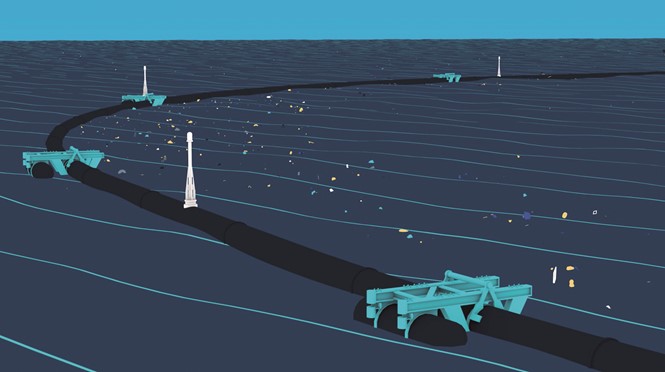Sustainable futures: Maersk
Maersk Supply Services is working in partnership with the Ocean Cleanup to tackle the major problem caused by the Pacific garbage patch. Its approach to sustainability runs deep throughout the business as the company ensures all of its sustainability activities relate back to its operations and services. Brittany Golob reports
Shipping and logistics firm Maersk is nothing if not intrinsically tied to the ocean. Its fleet of ships is hundreds strong and uses the world’s oceans as a motorway, shuttling goods from place to place and facilitating a globalised economy. But if those oceans become polluted beyond help, that poses a problem not just for fish, but for Maersk’s ability to carry out its services effectively. To lead the charge in changing this, Maersk has announced a revolutionary project to clean up the Pacific plastic patch.
Maersk has a long history of sustainable business, working across recycling, the circular economy, responsible business practices, food conservation and decarbonisation. The Ocean Cleanup project is a landmark though, in commercial commitments to lessening the impact humans have had on the seas.
The garbage patch gained notoriety earlier this year because of LADBible’s ‘Trash Isles’ campaign, highlighting the massive problem floating in the middle of the north Pacific. Its size, remoteness and nature has posed a challenge to clean up options. The Trash Isles concept saw celebrity ambassadors and other influencers lobby the UN for the establishment of a rubbish country, as per the UN’s guidelines on country qualifications in the supranational organisation. It helped raise awareness, and picked up a hefty number of Cannes Lions trophies in June as well.
But awareness is not enough to deal with the very real problem that five trillion pieces of garbage pose.
Maersk Supply Services – the logistics backbone of the global energy sector – is now armed with new technology and a fleet of ships capable of reaching the patch, suing for change.
Working with the Ocean Cleanup, a Rotterdam-based charity founded in 2013 with the aim of ridding the oceans of plastic, the technology engineered by the non-profit, called System 001, is revolutionary for floating plastic collection. Up to 60 buoy systems at 600m long will be deployed throughout the patch, shepherding the plastic floating above, and lurking just below, the surface into a smaller area. Then, a Maersk ship will periodically come and collect the rubbish, returning it to land to be recycled. The system is free floating, solar powered and will not harm sea life.
Annette Stube, head of group sustainability for Maersk Group, says Maersk Supply Services was a logical partner for the Ocean Cleanup’s endeavour. The latter required support services and transportation and the former has diversified its offer beyond simply working with extractives firms. “They can really do what they do best,” she says of Maersk Supply Services’ participation in the project. “They have 15 years of experience in working in harsh weather, on the high seas, in a safe and efficient manner. Using their particular competencies in solving this problem seems like the right thing to do.”
“If there’s no business incentive, then it’s just a nice little side project that will go away if next year is
a hard year. It’s important
to us that we identify some of these problems where we can actually make
a difference”

System 001 was deployed out of San Francisco and will have to withstand the harsh reality of the Pacific – where it may suffer storms, salt damage and wind. However, because it is free-floating, the Ocean Cleanup hopes the system will literally roll with whatever the Pacific throws at it. The system is projected to clean up 50% of the patch every five years. If it succeeds, it will be the first time large amounts of free-floating plastic will have been collected at sea.
Once System 001 is deployed, tested and evaluated, those findings will help Maersk Supply Services and the Ocean Cleanup to improve the system. However, System 002 is set to be developed concurrently with the deployment of System 001 so that it can be deployed when System 001 is retired after 2019.
The trials in September were successful and System 001 has since been put into operation in its target zone, about 1,700 kilometres northeast of Honolulu. The plastic will be shipped back to San Francisco for recycling.
“The world needs a healthy environment to prosper and to grow and so does business,” Stube says. “For us, it’s important that we work in environments that are working well, that are good and healthy and we want to contribute to that in ways that make sense to us as a business as well.” She says the partnership’s goal of shrinking the garbage patch by 50% in five years is its stated objective, but the programme will also raise awareness for the problem. By taking part, Maersk is fulfilling the onus placed on humanity to do something about its collective mistreatment of the oceans. It is also bringing the clout of a global business and its media coverage to bear, drawing awareness to the problem and perhaps prompting behaviour change in the future. “Even if the project succeeds and takes out the amount of plastic that it aims to, I think the bigger impact is really the awareness raising that it creates,” Stube adds.
The project was officially launched on 8 September, with a low speed test of the technology charged with the cleanup. Karstensen says this is one of the ways in which Maersk Supply Services is working with partners to improve access to renewable energy globally.
One of the world’s biggest offshore energy services firms, Maersk Supply Services has a vested interest in the deep seas. It supports towing and mooring, subsea construction, subsea wells and offshore wind. But, one of its core business functions is ocean cleanup.
For A.P. Moller-Maersk, Maersk Supply Services’ parent company, sustainability is strongly woven into all areas of the business’ operations. Regarding ocean health, the company’s sustainability report states an interest on the part of stakeholders in the long term viability of the oceans. It states, “As a citizen of the oceans, our stakeholders expect us to contribute to finding solutions.” The report also states the goal of moving away from compliance-driven sustainability activities and toward world-leading activities with regards to the sea.
It focuses specifically on partnerships and projects that have an impact on its business or that it can impact by operating in a more responsible manner. It often works in partnership, like with the Pacific cleanup. But, everything has to come back to the business and its purpose. “If there’s no business incentive, then it’s just a nice little side project that will go away if next year is a hard year,” Stube says. “It’s important to us that we identify some of these problems where we can actually make a difference and on which we can be sustainable also from a business perspective.”
Doing so sees Maersk work with partners like the World Ocean Council and the Sustainability Council to minimise the impact Maersk’s operations has on the seas while working toward larger goals like the Pacific Ocean Cleanup. Partnerships can also see scientists working aboard Maersk vessels to improve the carbon footprint of the shipping industry and study the oceans in further depth.














